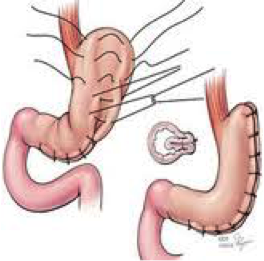Introduction
Gastric plication is part of the emergent interventions, even if the first interventions date back more than 10 years, this intervention knows a strong diffusion in the world and a weak diffusion in Europe. Indeed, it was originally described in countries where the cost of sleeve gastrectomy, especially in mechanical suture, made the intervention less feasible in volume as in our countries. The results published with 12 years of hindsight have pushed us to carry out this intervention with some technical modifications that we find interesting. The first results are encouraging with a low rate of complications, and especially no severe complications as can be seen after sleeve gastrectomy.
The intervention was described 12 years ago by Dr. Talebpour, the first technique was to perform the plication on a row without releasing the large curvature the last technique a double row of burial of the stomach with release of the great curvature.
The procedure requires approximately 48 hours of hospitalization.
It can cause nausea and vomiting lasting up to 8 days.
Technique

These are five or six small incisions in the abdomen and performing the procedure using a video camera (laparoscope) and long instruments that are placed through these small incisions. We apply a continuous suture to make large folds in your stomach.
During plication of the stomach, the volume is reduced by about 70% which makes the stomach able to contain less and can help you eat less. There is no cutting, stapling, or removal of the stomach or intestines during gastric plication. Gastric plication can potentially be reversible or converted to another procedure if necessary.
The procedure is minimally invasive and takes approximately one to two hours of operating time. Most patients stay in the hospital 1-2 days after the procedure.
How does the gastric plication make you lose weight?
Plication of the stomach is a restrictive procedure. It significantly reduces the size of your stomach and limits the volume of food that can be eaten at any given time. It does not cause a decrease in the absorption of nutrients or short circuits in your intestines.
After eating a small amount of food, you feel full very quickly and continue to feel full for several hours. Gastric plication can also lead to a decrease in appetite.
Who is a candidate for plication of the stomach?
The procedure is relatively new, considered to be a primary procedure for weight loss. The procedure should be likened to sleeve gastrectomy. We do not yet have any long-term results. The first results are encouraging, but we do not yet have enough perspective to offer this intervention to many patients. Patients are included in a cohort follow-up to assess the results.